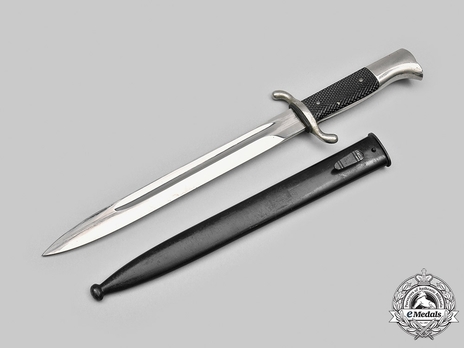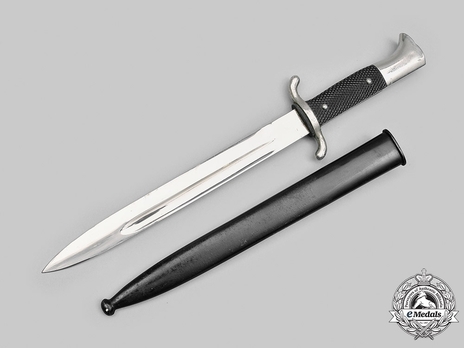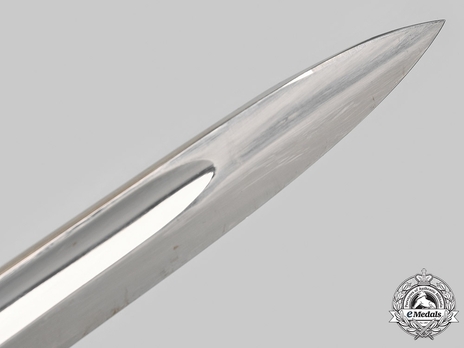Firefighters Enlisted Ranks Bayonet
CATEGORY: Version
SKU: 74.GOR.04.002.000
Estimated market value:



Estimated market value:
Measuring 405 mm in total length when inserted into the scabbard. It features a 250 mm-long magnetic metal blade with a sharpened tip and semi-sharpened lower edge, and with fullers running the length of each side. The blade sits securely within a nickel-plated upper crossguard, presenting with hooked quillons, which transitions into a one-piece hilt. The seam of the blade and crossguard is covered by a fully intact black leather buffer pad. Two pieces of pebbled black bakelite comprise the handle grip, and are secured in place with dual magnetic metal rivets. As a dress uniform accessory, the bayonet does not have an insertion slot. It is accompanied by its period original scabbard, constructed of a black-painted magnetic metal shaft. Emanating from the side of the shaft is a downward-pointing hook for optional attachment to a frog. The throat retains a functional spring catch, securely holding the bayonet in place during storage. It is secured together by a single visible side rivet. Unmarked, the bayonet demonstrates only minor signs of age and use, including slight running marks to the blade and some oxidation of the nickel-plated and magnetic metal features. It is in an overall near extremely fine condition.
Before the NSDAP’s rise to power in 1933, firefighters and their regulations were overseen by the individual German states. Fire services were more or less run by the communities as they saw fit. Larger towns and cities featured professional fire services (Berufsfeuerwehr), while rural areas featured volunteer fire services (Freiwillige Feuerwehr).
Under Third Reich rule, fire services were to be unified on a national level and therefore placed under the control of the German Police. National socialist doctrine was infused and the fire services militarised in preparation for war and the anticipated bombing of German cities.
Between 1933 and 1938, the professional fire service was referred to as “Feuerlöschpolizei” (fire extinguishing police), while between 1938 and 1945, they were referred to as “Feuerschutzpolizei” (fire protection police) as a subdivision of the German Police.
Volunteer firefighters were classified as part of the Hilfspolizei (police auxiliary forces).
Firefighter uniforms had generally been made of dark blue material, predominantly in Prussia. This colour was still used during the 1930s, but then changed in 1939 when members of the professional fire service received a green uniform similar to that of the German Police. The uniform garments featured carmine piping and initially black, later dark brown (as of September 1942) collars, cuffs, and cap bands as identifiers. However, volunteer firefighters kept wearing dark blue uniforms with carmine piping until the end of the war.
Members of Enlisted Ranks among firefighters wore a bayonet rather than a dagger. It is nickel-plated and features a checkered black grip. The pommel is in the shape of a stylized eagle’s head. Contrary to other bayonets, this one did not feature a way to be fitted to a rifle. Additionally, it stands out by having a recurve crossguard.
Lower Enlisted Ranks wore a 400mm long bayonet, while higher Enlisted Ranks wore a 350mm long one. Both could feature a sawtooth back. Rare examples feature personalised inscriptions.
A variant has been found that features unplated hilt fittings as well as a bronze Police eagle emblem insignia fitted to the grip.

Comments
Sign in to comment and reply.


Scroll Top